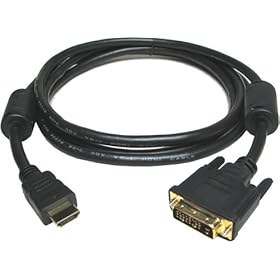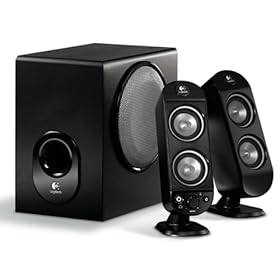 This topic is a little step away from my usual content but the question has come up a couple of times lately and I thought I'd post a "How To" guide.
This topic is a little step away from my usual content but the question has come up a couple of times lately and I thought I'd post a "How To" guide.Many owners are content with using their TV for PlayStation 3 games and Blu-ray DVD. Some will be taking advantage of recent advances in HDTV and using an HDMI cable, while others are stuck with standard TV via an RCA AV cable or SCART (in Europe).
If you own a recently manufactured LCD monitor, then it's possible that you could take advantage of the PS3's HD capabilities without having to shell out for a new HDTV. Many LCD models feature a DVI input (digital) as well as SVGA (analog).

Converting HDMI -> DVI
The PlayStation3 has two different audio/video outputs. The HDMI (High-Definition Multimedia Interface) port will transmit uncompressed digital data for video and audio. We can covert this to a monitor friendly format by using a HDMI->DVI cable. This cable drops the audio data but allows the digital video data to plug into a standard monitor DVI input. I'm using one of these cheap HDMI->DVI cables into a LG FLATRON W2042T and I'm more than happy with the result. The monitor also accepts SVGA which I use for my PC and switch between the two using the monitor's "Source" button.
 What about audio?
What about audio?The HDMI->DVI conversion drops the audio data - since most monitors don't support audio, especially not digital audio, you're probably going to need something else to produce the sound. The PlayStation 3 simultaneously produces output on both HDMI and AV channels, so we can use the AV audio feed. In my set up I am plugging the Red and White RCA leads into a Logitech X-230 Multimedia Speaker System via an adaptor that came with the speakers (2x RCA female to stereo 3.5mm female). This is probably the best sounding system in the lower price bracket and features a handy headphone jack on the front of one speaker.
What about Xbox 360?
As I understand it, this technique will not work with the the XBox 360 as it only transmits data on either HDMI OR standard AV. Apparently you can plug your Xbox 360 into SVGA using this Xbox 360 VGA Component Audio Cable. I've not seen the output quality, but from what I've read it's quite acceptable, although some users experience ghosting on text.

 Search Engine Optimisation (SEO) is often thought of as a mystical dark art. Many folks are making a good living off giving advice on how to increase your ranking in the major search engines, some of them even know what they're talking about. In many cases the "tricks" involved are common sense and can be implemented without too much trouble. The clever part is recognising what is the best approach for each particular site.
Search Engine Optimisation (SEO) is often thought of as a mystical dark art. Many folks are making a good living off giving advice on how to increase your ranking in the major search engines, some of them even know what they're talking about. In many cases the "tricks" involved are common sense and can be implemented without too much trouble. The clever part is recognising what is the best approach for each particular site.